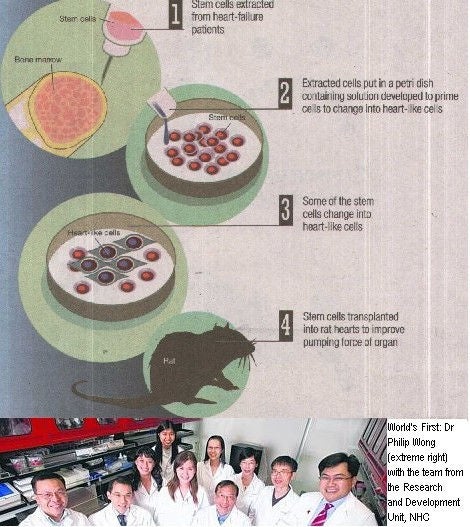
A team of Singapore doctors and researchers from the National Heart Centre Singapore have come up with a way of using an adult's stem cells to improve the pumping force of their failing hearts. A world first, it was presented at a conference in Germany yesterday.
WHAT HAVE THEY DISCOVERED?
Their research has found that heart-like cells generated from an adult's own stem cells using the National Heart Centre Singapore's (NHCS) patented method, have contributed to increasing the pumping force of the heart.
This is important for a patient with heart failure as the condition causes the heart to pump less forcefully and can lead to breathlessness, fatigue and weakness.
Dr Philip Wong, a senior consultant in the department of cardiology at NHCS, and director of its research and development unit, said: 'We took stem cells from 43 heart failure patients, put them in a petri dish, developed a solution that primes these cells to change into heart-like cells.'
The stem cells were transplanted into rat hearts during the research process.
DID IT WORK?
Their study found that in 100 of these cells, 30 of them will convert into heart-like cells.
Dr Wong: 'Heart-like cells are better than other stem cells in helping to improve heart function.
'Once they have converted, they feel at home and they know where to go in the areas of the heart that require them.'
If it were unconverted stem cells, they tend to get distributed all over and they are not effective in helping to improve the heart function, he said.
WHO WILL IT HELP?
Heart failure patients.
Many heart-attack patients suffer irreversible injury to the heart, leading to heart failure and its symptoms.
Dr Wong said there are 500 new heart failure patients in Singapore every year.
'For patients with severely damaged hearts, whole organ heart transplant is sometimes the only hope, but the challenge lies in finding a donor,' he said.
'For many of these patients, doctors use treatments such as stents, ballooning, bypass, but they end up still having heart-failure symptoms.'
WHAT WILL PATIENTS GO THROUGH?
Through the processes developed by NHCS, a patient with heart failure can potentially:
- Harvest his own stem cells
- Process them in a lab over a few weeks to optimise them
- Transplant his own converted heart-like cells back into his heart to help 'repair' or 'heal' the heart.
"This may alleviate his symptoms and delay the need for a whole-organ transplant," Dr Wong said.
Since the process is using a patient's own cells (autologous), immunosuppressants to prevent rejection will not be needed.
WHAT'S NEXT FOR THE RESEARCHERS?
The study is in its sixth year and 10 team members are working on it.
A patent was filed by NHCS for the isolation and expansion of the heart muscle-like cells in 2003.
Now that part one of the process is done, the second to fifth parts of the process can take place. They are:
- Build laboratory infrastructure next to hospital wards to process the stem cells in clean environments and to transplant into patients.
- Raise about $10 million to $15 million from grants to bring study results to next stage
- Begin human trials
- Begin big human trials (involving many more patients)
- It becomes standard of therapy for patients.
SO WHEN WILL IT HAPPEN?
It will take one or two years to get to human trials. Then it will take another few years to become standard of therapy for patients.
WHAT'S THE SECRET?
'What's in the solution to prime the stem cells? Can't tell you, that's our trade secret,' Dr Wong said.
Source: The New Paper
© Singapore Press Holdings Limited. Permission required for reproduction.













 Get it on Google Play
Get it on Google Play